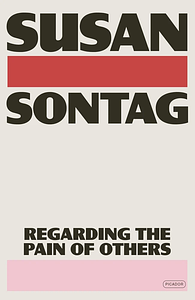You need to sign in or sign up before continuing.
Take a photo of a barcode or cover
challenging
dark
informative
reflective
slow-paced
emotional
reflective
slow-paced
This meditation on the power, use and misuse of the imagery of pain and suffering is just as pertinent today as it was when Sontag wrote this 20 years ago - if anything the sharing of images & videos of peoples pain has become even more prevalent, polarizing, and thoughtless through social media and the escalation of violence within various entertainment forms.
So far as we feel sympathy, we feel we are not accomplices to what caused the suffering. Our sympathy proclaims our innocence as well as our impotence. To that extent, it can be (for all our good intentions) an impertinent — if not an inappropriate — response.
What this book offers: interesting thoughts on how we relate to photos of suffering, and on the history of war photography; numerous references to morbid photos and films
What not to expect: many clear conclusions
این کتاب رو توی حلقه با هم توی یک ماه خوندیم.
سانتاگ در کتاب بیشتر در مورد عکاسی جنگ صحبت میکنه. عکاسی چون یکی از رایجترین راههای نظر کردن به رنجهای بزرگه، و جنگ چون یکی از بزرگترین رنجهای بشریته.
برای من حرفهایی هم تحلیلی و هم تاریخی خوبی داشت. چون زیاد به عکس و نقاشیهای مختلف ارجاع میده و در موردشون صحبت میکنه، خیلی خوب میشه که سرچ کنید و عکسها رو ببینید و به صورت فعال کتاب رو بخونید.
سانتاگ در کتاب بیشتر در مورد عکاسی جنگ صحبت میکنه. عکاسی چون یکی از رایجترین راههای نظر کردن به رنجهای بزرگه، و جنگ چون یکی از بزرگترین رنجهای بشریته.
برای من حرفهایی هم تحلیلی و هم تاریخی خوبی داشت. چون زیاد به عکس و نقاشیهای مختلف ارجاع میده و در موردشون صحبت میکنه، خیلی خوب میشه که سرچ کنید و عکسها رو ببینید و به صورت فعال کتاب رو بخونید.
“remembering is an ethical act, has ethical value in and of itself. memory is, achingly, the only relation we can have with the dead. so the belief that remembering is an ethical act is deep in our natures as humans, who know we are going to die, and who mourn those who, in the normal course of things die before us—grandparents, parents, teachers, and older friends. heartlessness and amnesia seem to go together. but history gives contradictory signals about the value of remembering in the much longer span of a collective history. there is simply too much injustice in the world. and too much remembering embitters. to make peace is to forget. to reconcile, it is necessary that memory be faulty and limited.”
challenging
informative
reflective
medium-paced
"So far as we feel sympathy, we feel we are not accomplices to what caused the suffering. Our sympathy proclaims our innocence as well as our impotence."
De perlas para el trabajo de critica de la representacion
dark
informative
inspiring
reflective
medium-paced
This book is mistitled. It should be called Disregarding the Pain of Others. It is about photography and indifference to war more than it is about pain.
Where is the testimony of doctors, nurses, palliative care workers, anesthesiologists, and relief workers who have regular up close association with the pain of others?
I had hoped to think through our society's association with pain, causes, cures, and the sources of our indifference. This is not that book, my error.
In the end, Sontag directs us to Jeff Wall's image of the horror of war as a last statement to her case about the pain of war, Dead Troops Talk (A Vision after an Ambush of a Red Army Patrol, near Moqor, Afghanistan, Winter 1986), that this work subsequently sold in 2012 for 3.6 million is a more bracing indictment of our relationship to the sufferings of war and its depiction in Western society than the whole book.
Ironically this book is moral candy.
Where is the testimony of doctors, nurses, palliative care workers, anesthesiologists, and relief workers who have regular up close association with the pain of others?
I had hoped to think through our society's association with pain, causes, cures, and the sources of our indifference. This is not that book, my error.
In the end, Sontag directs us to Jeff Wall's image of the horror of war as a last statement to her case about the pain of war, Dead Troops Talk (A Vision after an Ambush of a Red Army Patrol, near Moqor, Afghanistan, Winter 1986), that this work subsequently sold in 2012 for 3.6 million is a more bracing indictment of our relationship to the sufferings of war and its depiction in Western society than the whole book.
Ironically this book is moral candy.




